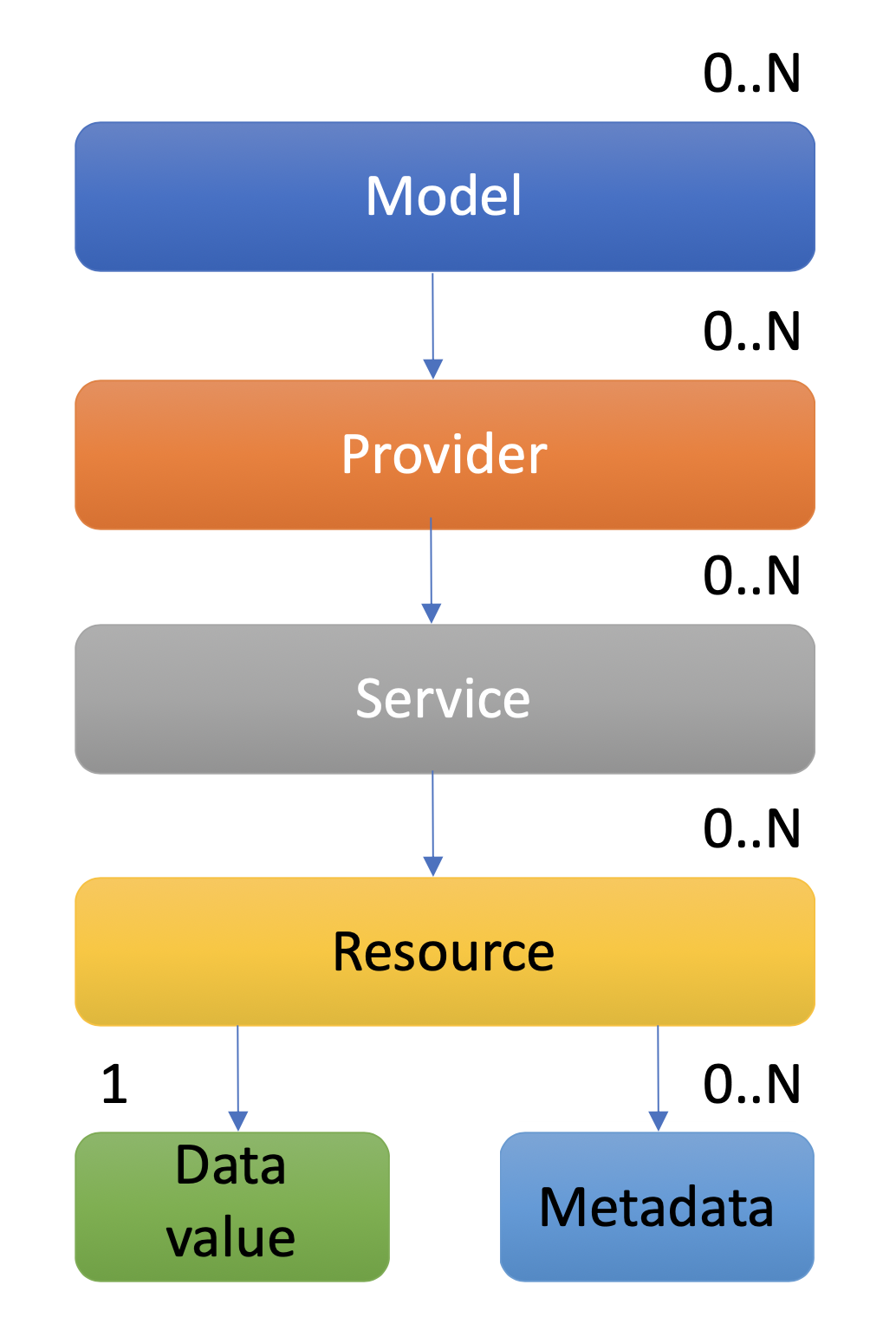The sensiNact core model¶
The sensiNact core model describes the interactions and in-memory representation of the sensiNact “digital twin”, i.e. a virtual representation of the state of sensors and actuators connected to the sensiNact gateway.
The sensiNact core data model is broken down into Resources, Services and Providers which are interacted with using the verbs GET, DESCRIBE, SET, ACT, SUBSCRIBE and UNSUBSCRIBE
Verbs¶
The sensiNact verbs are conceptually similar to the verbs in HTTP. They represent a common set of instructions that can be used to query or change the state of a sensiNact gateway.
Read only verbs¶
The following verbs are used to interrogate the state of the gateway without changing it
GET¶
The simplest verb is GET which is a request to read a Resource’s value, or one of its metadata values, from the sensiNact gateway.
DESCRIBE¶
The DESCRIBE verb is another read request, but rather than providing access to data or metadata values it provides information about the structure of the described part of the data model. For example a DESCRIBE operation on a Provider will list the Services for that Provider, whereas a DESCRIBE on a Resource will list information about the data and metadata values for the Resource.
SUBSCRIBE¶
The SUBSCRIBE verb allows the caller to watch for changes in the target part of the data model, for example:
Lifecyle events for the creation/deletion of a Provider, Service or Resource
Changes in the values of Resource metadata
Changes in the value of a Resource
Actions ocurring on a Resource
UNSUBSCRIBE¶
The UNSUBSCRIBE verb allows the caller to remove a subscription from an earlier SUBSCRIBE call
Edit operations¶
The following verbs are used to change the state of the gateway, and potentially the devices connected to it
SET¶
The SET verb is used to change the value of a Resource or to change the metadata associated with a RESOURCE
ACT¶
The ACT verb is used to trigger an Action Resource, potentially passing one or more parameters to a device, and potentially returning a value.
The core data model¶
The sensiNact core data model is composed of Resources, Services and Providers, which are arranged in a tree-structure. The definition of the structure for a provider is referred to as the provider model.
A Resource is the lowest level of the sensiNact data model. A resource represents a single sensor, actuator or state variable within the digital twin. There are two types of Resources, data resources and action resources
Data Resources¶
A data resource has a single value associated with it representing the data it provides.
A resource also has zero or more metadata entries associated with it. For brevity we will use the term field to refer to both value and metadata entries.
The fields of a resource have associated time stamps representing the times at which they were last updated. They also have an associated property indicating how their value can change.
Read-only fields¶
A read-only field is one cannot be changed by sensiNact. Read-only fields may be UPDATABLE and have the potential to change over time (e.g. the data reading from a sensor) or FIXED and unchanging (e.g. a hardware identifier reported by a device).
The value of a read-only field can be queried using the GET verb, or watched using the SUBSCRIBE verb.
MODIFIABLE fields¶
A MODIFIABLE field is one that can be changed by sensiNact. It may represent a configuration property for a device, or a direct output.
The value of a MODIFIABLE field can be queried using the GET verb, watched using the SUBSCRIBE verb, or changed using the SET verb.
Action resources¶
Action resources are similar to data resources, but do not have a value that can be queried. Action resources represent some actuation capability of a device. Action resources can be triggered using the ACT verb. Action resource metadata will include information about the parameters that can be passed when triggering the action.
Services¶
A service is a logical grouping of one or more resources that are related, for example a smart plug might have two services:
switch- a service representing the switching capability of the smart plugstate- a resource representing the state of the switch, eitherONorOFFtoggle- an action resource which changes the state of the switch
monitor- a service representing the power monitoring for the smart plugcurrent- a resource providing the current passing through the plugpower- a resource providing the power passing through the plug
Providers¶
A Provider is a logical representation of a device, group of devices, or physical object, that should be available within sensiNact. Each Provider will contain one or more Service entries. The description of the services and resources associated with a provider is known as the provider model.
The admin Service¶
All Provider instances have an implicit service called admin. The admin service provides information that sensiNact holds about the device. This information may, or may not, correspond to information actually provided by the device.
friendlyName- a human readable name for this devicelocation- a GeoJSON string representing the location of this deviceicon- an icon to use when representing this device
Looking for more detail?¶
More detail about the data model can be defined and interacted with is available here
